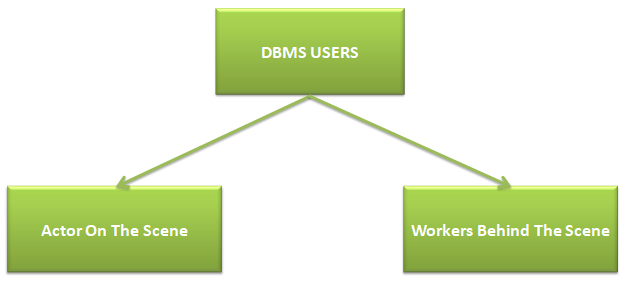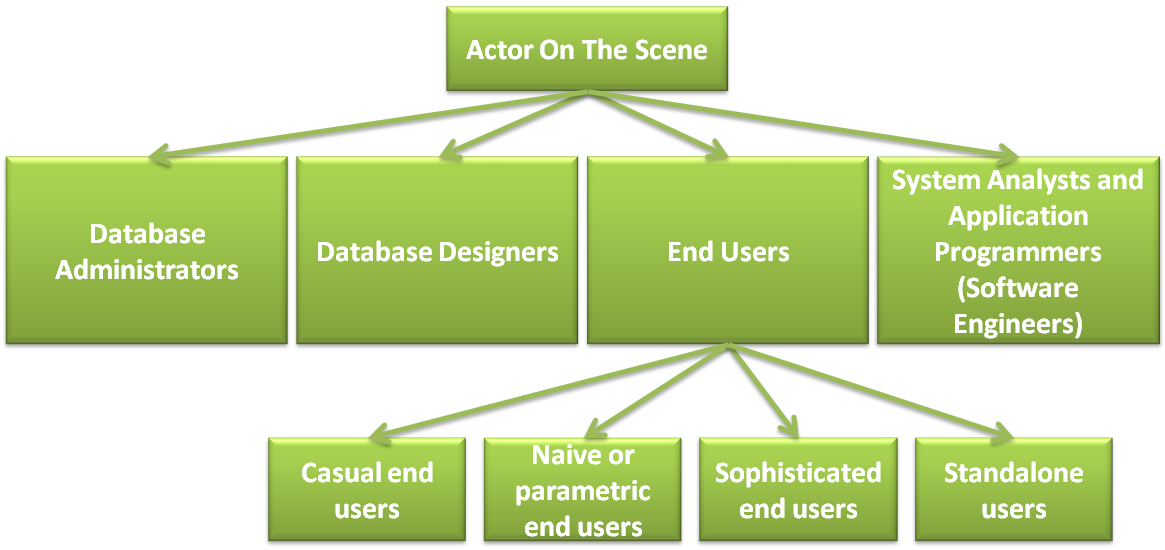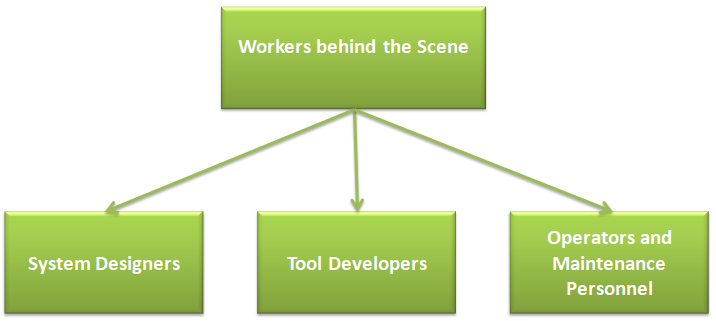Different Types of DBMS Users play critical roles in ensuring the smooth operation of database systems. From managing access and performance to designing, developing, and using data-driven applications, these users contribute to the database lifecycle in unique ways. Understanding who these users are and what they do helps in structuring efficient workflows and maintaining data integrity.
Table of Contents
Primary Classification of DBMS Users
DBMS users are typically categorized into two broad types:

- Actors on the Scene – Users who directly interact with the database for various operational or business tasks.
- Workers Behind the Scene – Technical personnel who develop, manage, and maintain the database infrastructure.
Actors on the Scene: Frontline DBMS Users

1. Database Administrators (DBAs)
DBAs are the gatekeepers of database systems. They control access permissions, manage performance tuning, implement security policies, and ensure backup and recovery mechanisms are in place.
Responsibilities of DBAs include:
- Managing user roles and privileges
- Configuring performance and optimization settings
- Ensuring high availability and disaster recovery
2. Database Designers
Database Designers are the architects who define the logical and physical structure of a database. They model data, establish relationships between tables, and ensure normalization for efficient storage and retrieval.
Key tasks include:
Collaborating with DBAs and developers
Entity-Relationship (ER) modeling
Translating business requirements into database schemas
3. End Users
End users are individuals who interact with the database in various ways, depending on their roles and technical proficiency. They fall into the following categories:
a. Casual End Users
These users access data occasionally using simple queries or reports. Examples include managers checking monthly sales reports.
b. Naive or Parametric Users
They use predefined queries or forms regularly. Common in banking systems (e.g., clerks updating customer details).
c. Sophisticated Users
Technically proficient users who write complex SQL queries or use advanced tools for data analysis. Often includes data analysts and researchers.
d. Standalone Users
Use dedicated database applications for personal or small-business use. These users often manage simple databases with GUI tools like Microsoft Access.
4. System Analysts and Application Developers
These users act as bridges between end users and the DBMS. They collect user requirements, design interfaces, and develop applications that interact with the database through APIs or direct queries.
Roles include:
- Designing user interfaces
- Writing stored procedures and functions
- Developing middleware and database applications
Workers Behind the Scene: The Technical Backbone

1. DBMS System Designers and Implementers
These professionals are responsible for developing the DBMS software itself. They handle internal architecture, design query optimizers, storage engines, and concurrency mechanisms.
Their responsibilities include:
- Implementing DBMS features and modules
- Ensuring scalability and robustness
- Supporting standards like SQL, ACID, etc.
2. Tool Developers
Tool Developers design additional utilities that extend the DBMS’s capabilities. These tools assist in performance monitoring, schema visualization, and database migration.
Examples of DBMS tools:
- SQL Profiler
- Database schema diagram generators
- Data visualization dashboards
3. Operators and Maintenance Personnel
This group ensures daily operation and uptime of the database systems. They monitor hardware, maintain operating environments, and resolve connectivity or storage issues.
Key tasks:
- Monitoring system logs and alerts
- Managing hardware, servers, and backups
- Applying OS and DBMS updates
Importance of Collaboration Among Different Types of DBMS Users
Effective collaboration between all DBMS user types ensures that the system is:
- Efficient: Designers and developers optimize structure and performance.
- Secure: DBAs and tool developers enforce access control and monitoring.
- User-Friendly: Analysts and developers create intuitive interfaces.
- Resilient: Operators and implementers build and maintain robust systems.
Modern Trends Impacting DBMS User Roles
1. Rise of Cloud Databases
Cloud platforms like AWS RDS and Azure SQL Database require DBAs to adapt to new roles, focusing on configuration rather than installation.
2. Integration with Data Science and AI
Sophisticated users now include data scientists using SQL, Python, and ML tools to query and analyze massive datasets from modern DBMS platforms.
3. DevOps and CI/CD Integration
Application developers now work in DevOps teams, using tools like Flyway or Liquibase for database version control and deployment automation.
Frequently Asked Questions: Different Types of DBMS Users
Q1. What are the main categories of DBMS users?
DBMS users are categorized into actors on the scene (like DBAs, designers, end users) and workers behind the scene (such as system developers and operators).
Q2. Who is responsible for securing the DBMS?
Database Administrators (DBAs) primarily handle security by setting access controls, monitoring logs, and applying patches.
Q3. What is the difference between a database designer and a developer?
A designer focuses on database structure and modeling, while a developer creates applications and interfaces to interact with that database.
Q4. Can an end user write SQL queries?
Yes, sophisticated end users often write custom SQL queries for advanced data analysis. Others use predefined interfaces or forms.
Q5. What tools do DBMS tool developers create?
They develop tools like ER diagram generators, performance analyzers, migration utilities, and query optimizers to enhance DBMS usage.
Conclusion: Understanding the Different Types of DBMS Users
Recognizing the different types of DBMS users is essential for designing, managing, and scaling a successful database environment. From the system-level engineers who build the DBMS to the everyday users who query it for reports, each role is crucial.
Whether you’re planning a career in database administration, development, or design—or simply trying to optimize your system—understanding these user roles ensures better collaboration, smoother operations, and more effective data utilization.